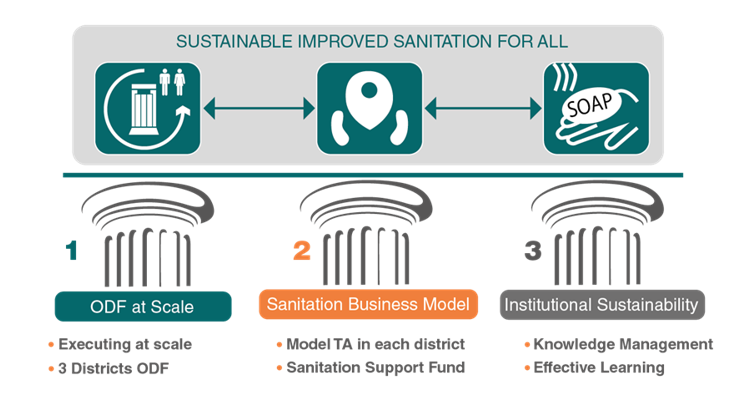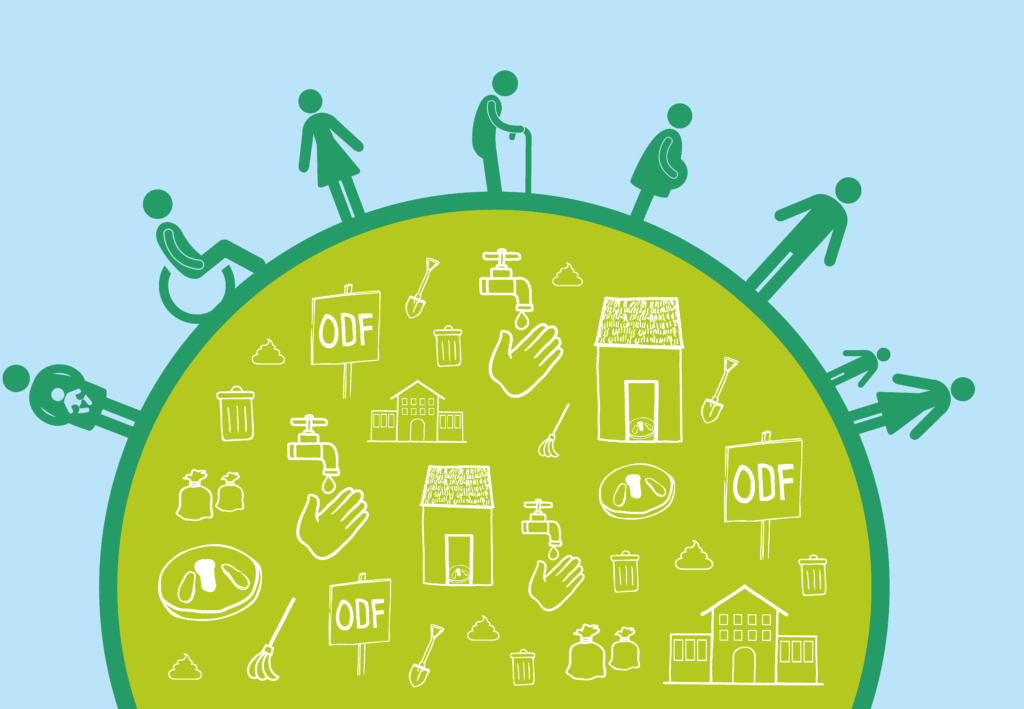In 2016, I co-authored a chapter on Community Led Total Sanitation (CLTS) and sanitation marketing for the book Sustainable Sanitation for All.
Now, seven years later, I reflect on what has changed and if the assumptions still hold. I clarify some of the approaches, actions, ideas, practices, and present achievements and lessons learned from the implementation of the Accelerated Sanitation and Hygiene Promotion Programme (ASHPP) on which the original chapter was based.
The ASHPP, was a five-year initiative (2010-2015) supported by the Water Supply and Sanitation Collaborative Council (WSSCC) through the Global Sanitation Fund (GSF) which was extended to 2017 for a period of 18 months. The extension phase was based on the Three Pillar (3P) model (see graphic below), which facilitated development of a demonstration model that would help address the gulf between basic and improved sanitation in an open defecation free (ODF) traditional authority (TA) area in each of the six targeted districts in Malawi: Rumphi, Ntchisi, Nkhotakota, Balaka, Phalombe and Chikwawa.
At the end of this blog I summarise the gaps, needs and ways forward for the sanitation sector in Malawi to make progress towards attaining the Sustainable Development Goals (SDGs).

Open Defecation Free status and slippage
During a period of two years (2011-2013), the programme experienced rampant slippages back to open defecation and slow triggering processes, as CLTS was being applied in a village-by-village approach. Therefore, the approach was changed to targeting large swaths of areas such as traditional authorities and districts. This change helped to fast-track activities and increased sustainability prospects. The new approach created a big movement, making sanitation and hygiene popular in a way that put pressure on every household to eliminate open defecation.
Strong leadership at higher levels such as traditional authorities helped to reinforce the project’s progress and sustainability. Traditional authorities wield more powers than village heads and put in place sanctions to prevent slippages within their areas of jurisdiction. For example, Traditional Authority Mwankhunikira in Rumphi district agreed a set of punitive measures with community members, e.g., fines paid in the form of a chicken or goat for practicing open defecation and unhygienic behaviour. In stark contrast, in places where traditional authorities were engaged but demonstrated weak leadership such as Chapananga in Chikwawa district, massive ODF slippages have been observed long after the project was closed.
ODF celebrations also played an important role in motivating community members to strive for attainment of ODF status. The celebrations served as learning events for other traditional authorities. This helped fast track achievement of ODF status within a year. The issuance of ODF certificates by traditional authorities added another dimension, with communities becoming proud of their achievement and striving to maintain their status and prestige. However, the benefits were observed only during implementation. It was assumed that these events would inspire adjacent traditional authorities or districts to sustain ODF status even long after the project ends. This assumption has been proved false as the current situation does not show any ripple effects after the project was closed.
Also, latrines built from materials such as grass for a superstructure are no longer visible. This conclusion was derived from observations when visiting the villages. What does this tell us about CLTS? Is it still a sustainable approach without emphasis on strong durable latrines? Further research is needed to understand this phenomenon as there is no available statistics yet to back up the findings.
Phasing
The development of an Integrated Sanitation Marketing, Financing and Information, Education and communication (ISMFIEC) strategy to help support households to move to the next level of the sanitation ladder was a worthwhile effort. The strategy helped to reap positive results through integrating CLTS with sanitation marketing. The Outcome Survey 2017 suggests that the integration of CLTS and sanitation marketing is linked with helping households move up the sanitation ladder. It also revealed that the uptake of improved sanitation in the project areas had increased to 18% from a baseline of 9.1%. This movement though, was not without huge investment in altering the trajectory from low to high number of improved latrines.
Economic activities such as village savings and loans, micro financing, revolving funds and innovative technologies were in part responsible for this success through bolstering purchasing power. This is a point that was not factored in when integration of CLTS and sanitation marketing was explained in the book chapter. Does this signal a need for incentivization or further financial support to achieve improved sanitation?
Conducting CLTS first and then sanitation marketing much later, resulted in proliferation of basic sanitation. This approach also created slippage in the long term as it became labourious and difficult to maintain latrines made from non-durable materials. In Malawi, materials for basic latrine are different from materials used for building an improved facility, a factor that makes it difficult to upgrade the same latrine without starting all over again. This scenario leads to slippages and is what we are experiencing now.
The assumption, outlined earlier in the original book chapter, that integrating CLTS and sanitation marketing is the best practice, still holds but other aspects such as economic situation and financing mechanisms have to be considered too.
Sanitation financing
The ISMFIEC strategy provided a framework for regulating sanitation financing. For instance, all households who accessed loans from a revolving fund at Traditional Authority Kaduya in Phalombe district had to use the funds for the sole purpose of sanitation. This strategy was not mentioned in the book chapter because it was implemented later in the programme. This framework aided implementation of a revolving fund in the six selected traditional authorities of the Accelerated Sanitation and Hygiene Promotion Programme (ASHPP).
The other model in Traditional Authority Kalembo in Balaka district, was achieved through village savings and loans. Further to what was discussed in the book chapter, this strategy helped to identify a list of marginalised individuals such as the widowed, the chronically ill, the ultra-poor and the disabled. The strategy also helped to uncover gaps on supporting disadvantaged people. For example, disabled persons were only assisted with pedestals for easy squatting during defecation but other aspects, such as roofing of their latrines, had been left unattended. A fully-fledged sanitation package was recommended and further research is required to identify the most effective financing model for assisting marginalized and disadvantaged individuals.
Masons and entrepreneurs
The issue of attrition, where the number of skilled masons and entrepreneurs was declining (which we touched on in the book chapter) remains a challenge. Attrition was attributed to unrealistic expectations at the inception of the project: the masons and entrepreneurs were still expecting to be paid by the project. “Although I was told that our compensation on our work is through the sanitation business I still feel project should also be paying” said one entrepreneur, John Njikho.
In Ntchisi district, World Vision International attempted to address this problem by offering soft loans as incentives to help retain masons’ or entrepreneurs’ services. The loans were agreed for purposes of purchasing tools like mason trowels, shovels and shiners. This was comparatively a better approach than training excessive entrepreneurs which had been the initial strategy explained in the book chapter. Further research is needed to gauge whether this soft loans approach works or not. To address this problem, I suggest training a larger number of rigorously vetted masons or private small-scale providers than a project need. The difference could be the rigorous vetting as most projects just accept individuals put forward by village heads. The vetting process should not be dominated by village heads but likeminded entrepreneurs.
Technical innovations and solutions to fit local contexts
The demand for fertilizers among small-scale farmers in Malawi is extremely high. The introduction of ecological sanitation helped to increase access to improved sanitation in the six targeted districts. Ecosan was eagerly adopted to boost crop production with ‘humanure’. It was also seen as a means to tackle the problem of pit latrine collapse in unstable soil conditions and waterlogged areas. The re-use of treated human excrement is a new development that was not wide-spread at the time of the book chapter. It is credited for contributing to a boom in the number of improved latrines. The results of implementing ecosan within the ASHPP support the argument made by Steven Sugden (2003) that ecological sanitation has the potential of revolutionizing the sanitation sector. “We managed to construct more latrines due in part to ecosan attributed benefits”, said Mr Maganga, a Project Manager for Hygiene Village Project in Nkhotakota district.
The funding of stand-alone ecosan projects still looks to be a farfetched dream. This is a funding blind spot where priorities are not informed by research or best practices. The dogmatic thinking that a Ventilated Improved latrine (VIP) is the best latrine for all rural households looms large in the WASH sector in Malawi and is partly to blame for this situation.
Moving forward to meet the SDGs
Based on learning from ASHPP, there are a number of key lessons for moving towards sustainable sanitation for all in Malawi:
- There is a need to source funding to support large-scale sanitation projects such as ASHPP for poor countries such as Malawi to scale up technologies and innovations, and create movements for sanitation and hygiene to meet the SDGs targets.
- Ecological sanitation (ecosan) has proven to work well in most parts of Malawi. Therefore, ecosan projects could be a game changer. Such projects should not be combined with conventional sanitation projects as the combination takes away focus on ecosan as most managers are swayed by VIP latrines.
- Strong community leadership has proven to be crucial to sustainability of sanitation projects to ensure communities live in cleaner and healthier environments. Consequently, strengthening community leadership should be an integral part of any sanitation programming.
- Comparatively, the activities for attaining ODF which were at the peak in 2016 have now subsided owing to the project ending and sub grantees no longer active. This scenario raises questions on what can be done to sustain momentum on sanitation beyond projects. Should we conclude that sanitation approaches such as CLTS only work as part of projects and programmes and are therefore temporary?







